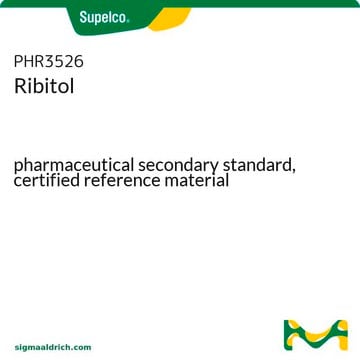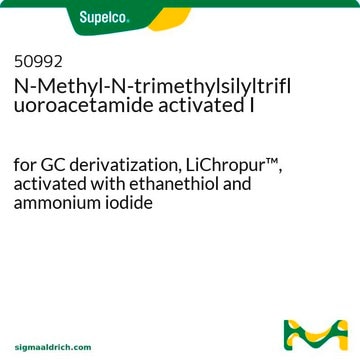89803
Methoxyamine hydrochloride
for GC derivatization, LiChropur™, 97.5-102.5% (AT)
Sinonimo/i:
O-Methylhydroxylamine hydrochloride, Methoxylamine hydrochloride
About This Item
Prodotti consigliati
Grado
for GC derivatization
Livello qualitativo
Saggio
97.5-102.5% (AT)
Forma fisica
crystals
Qualità
LiChropur™
Impiego in reazioni chimiche
reagent type: derivatization reagent
reaction type: Acylations
tecniche
gas chromatography (GC): suitable
Punto di fusione
151-154 °C (lit.)
Stringa SMILE
Cl.CON
InChI
1S/CH5NO.ClH/c1-3-2;/h2H2,1H3;1H
XNXVOSBNFZWHBV-UHFFFAOYSA-N
Cerchi prodotti simili? Visita Guida al confronto tra prodotti
Categorie correlate
Descrizione generale
Applicazioni
- A reagent for the preparation of O-methyl oximes.
- A reagent used to make O-methyl oximes from aldehydes or ketones.
- An alkylation reagent.
- It may be used as a derivatization agent to improve the sensitivity of opioids, steroids and ionic metabolites in biological samples and non-volatile flavor compounds in "Angeleno" plum fruit prior to the determination of analytes using gas chromatography-mass spectrometry (GC-MS) technique.
Note legali
Avvertenze
Danger
Indicazioni di pericolo
Classi di pericolo
Acute Tox. 4 Dermal - Acute Tox. 4 Oral - Aquatic Acute 1 - Aquatic Chronic 1 - Carc. 2 - Eye Irrit. 2 - Met. Corr. 1 - Skin Irrit. 2 - Skin Sens. 1 - STOT RE 1
Codice della classe di stoccaggio
6.1C - Combustible acute toxic Cat.3 / toxic compounds or compounds which causing chronic effects
Classe di pericolosità dell'acqua (WGK)
WGK 3
Punto d’infiammabilità (°F)
Not applicable
Punto d’infiammabilità (°C)
Not applicable
Choose from one of the most recent versions:
Possiedi già questo prodotto?
I documenti relativi ai prodotti acquistati recentemente sono disponibili nell’Archivio dei documenti.
I clienti hanno visto anche
Il team dei nostri ricercatori vanta grande esperienza in tutte le aree della ricerca quali Life Science, scienza dei materiali, sintesi chimica, cromatografia, discipline analitiche, ecc..
Contatta l'Assistenza Tecnica.












